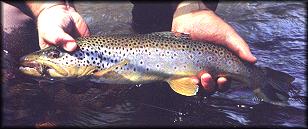Migratory Browns
By Chris Marshall
From an Interview of Glen Hales, Associate Photo Editor,
The Canadian Fly Fisher
Lake Ontario brown trout begin to enter the tributary streams close
on the heels of the chinook in early September. But their run is much
less concentrated than the chinooks, for it gradually builds until it reaches
its peak in late September and early October. Spawning usually takes
place in October, the the time will vary from year to year depending upon
rain, stream flow, and water temperature.
There are places, especially at the west end of Lake Ontario, where fly
fishers will target migrating browns as they run along shorelines towards the
river mouths, as well as when they concentrate in the mouths themselves.
However, they also offer challenging and exciting sport when they're in the
streams.

Yet few fly fishers pursue migratory browns once they've moved into the
streams. This is partly because the chinook and coho are so much bigger
and are much more noticeable when they hold right out in the open. But
the main reason is most likely because browns are much more wary, much
less easy to spot, and much more easily spooked. Herein lies both the
challenge and the delight.
Browns move primarily at night and seek cover during the day. Sea-run browns
in Europe, and on the Canadian east coast, especially follow this pattern, and are
almost exclusively fished for during the night. However, the browns of the
Great Lakes are sufficiently less nocturnal that they can be fished for effectively
during the daylight.
Glen Hales is a young guy, still in his twenties, yet he's one of the best
fly fishers around, especally for migratory trout and salmon in the small
tributaries on the north shore of Lake Ontario. The following information
is taken from years of depending on his eyes and his instincts on the stream.
Small Streams
The tributaries which feed the north shore of Lake Ontario from Brighton Bay
to the Niagara River are small. Beyond their interfaces with the lake, none are
more than 30 feet or so in width; many are much smaller. Consequently, fly
fishers wishing to target migratory browns once they're entered the streams are
obligated to do this in small spaces. These call for tactics somewhat different
from those used on larger tributaries. Essentially, anglers are obligated to
sight fish, stalking their targets in a style similar to that used for resident browns
on streams of similar size. Streamcraft and sneakiness are ninety percent of
the game.
When To Fish
On bright days, especially if the water is low and clear, migratory browns will
usually be tucked away in cover so deep that they'll be inaccessible. The low
light conditions of evening, early morning and dull days are the best times to
pursue them, when they are less wary and more likely to be holding where
they can be spotted and cast to. Similarly, a freshet after a rain and a touch
of colour to the water will also bring them out, although the more turbulent,
clouded can make spotting more difficult. ~ Chris Marshall
 Next time, Locating Fish and more.
Next time, Locating Fish and more.
We thank the Canadian Fly Fisher for re-print permission!
Our Man In Canada Archives
|



